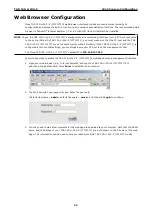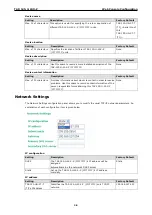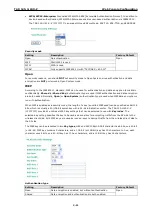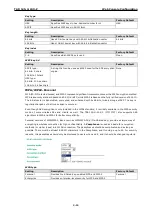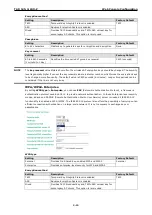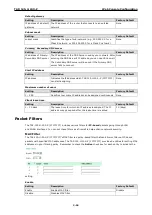
TAP-125-U-W-X-Z
(YYYYYYYY)
Web Console Configuration
3-15
DTIM Interval
Setting
Description
Factory Default
Data Beacon Rate
(1 to 15)
Indicates how often the TAP-125-U-W-X-Z (YYYYYYYY) sends
out a
Delivery Traffic Indication Message
1
RTS threshold
Setting
Description
Factory Default
RTS/CTS Threshold
(256 to 2346)
Determines how large a packet can be before the Access Point
coordinates transmission and reception to ensure efficient
communication
2346
WMM
Setting
Description
Factory Default
Enable/Disable
WMM is a QoS standard for WLAN traffic. Voice and video data
will be given priority bandwidth when enabled with WMM
supported wireless clients.
Disable
Advanced Settings
Several advanced functions are available to increase the functionality of your TAP-125-U-W-X-Z (YYYYYYYY)
and wireless network system. A VLAN is a collection of clients and hosts grouped together as if they were
connected to the broadcast domains in a layer 2 network. The DHCP server helps you deploy wireless clients
efficiently. Packet filters provide security mechanisms, such as firewalls, in different network layers.
Using Virtual LAN
Setting up Virtual LANs (VLANs) on your device increases the efficiency of your network by dividing the LAN into
logical segments, as opposed to physical segments. In general, VLANs are easier to manage.
The Virtual LAN (VLAN) Concept
What is a VLAN?
A virtual LAN, commonly known as a VLAN, is a group of hosts with a common set of requirements that
communicate as if they were attached to the same broadcast domain, regardless of their physical location. A
VLAN has the same attributes as a physical LAN, but it allows for end stations to be grouped together even if
they are not located on the same network switch. Network reconfiguration can be done through software
instead of physically relocating devices.
VLANs now extend as far as the reach of the access point signal. Clients can be segmented into wireless
sub-networks via SSID and VLAN assignment. A Client can access the network by connecting to an AP
configured to support its assigned SSID/VLAN.
Benefits of VLANs
VLANs are used to conveniently, efficiently, and easily manage your network in the following ways:
•
Manage adds, moves, and changes from a single point of contact
•
Define and monitor groups
•
Reduce broadcast and multicast traffic to unnecessary destinations
•
Improve network performance and reduce latency
•
Increase security
•
Secure network restricts members to resources on their own VLAN
•
Clients roam without compromising security


